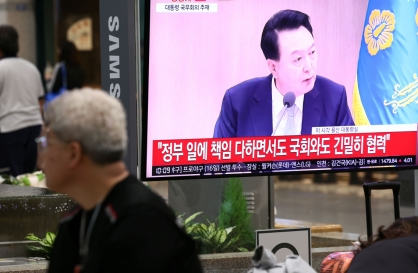Iran has represented many things to many people during its 40 years of Islamic revolution. To the Arab world that surrounds it today, it’s both a danger and an excuse.
Arab reaction to the 1979 Iranian revolution was split from the onset, and still is. Arab governments, particularly in the Gulf region reacted in a panic, hurriedly forming the now barely functional Gulf Cooperation Council for collective self-defense.
The Arab states of North Africa, notably Egypt, barely noticed the upheaval in Tehran, with one important exception: Ayatollah Ruhollah Khomeini’s Shiite revolution radicalized and emboldened Sunni Arab Islamists throughout the region.
The new Islamic Republic in Iran gave those Arab Islamists, ranging from Muslim Brothers to those who would eventually emerge as al-Qaida and the Islamic State group, a model of success. From their perspective, Iranian Islamists may get many aspects of the religion wrong, but if they could overthrow a strong government of a powerful state against the wishes of both the US and the Soviet Union, then surely the sky was the limit for those with a better version of religious fundamentalism and revolutionary politics.
Sunni Arab Islamists both emulated Iranians and competed with them. The first major test came with the Soviet invasion of Afghanistan, which occurred just a few months after the Iranian revolution.
Guided by Pakistan, Saudi Arabia and the US, Sunni Islamists from around the Arab world and beyond converged on Afghanistan to fight the godless communists. When they emerged “victorious,” fanatics believed they had demonstrated their superiority. Some of them went on to found al-Qaida.
For years, they convinced themselves they could also crush the US, and some still believe that.
US-aligned Muslim countries, notably Saudi Arabia and Pakistan, tacked sharply to their own versions of the religious right to avoid being outbid by a local Khomeini analog -- again setting the stage for the rise of violent extremists.
Convincing Arab Shiites to embrace revolutionary Iran proved more difficult. But Iranian revolutionaries found they could rely on the support of their enemies at every stage.
Seeking to export their revolution, Iranian agents tried to use nonstate Arab actors to do their bidding. The first and still most successful experiment came with the sponsorship of Hezbollah in Lebanon following the Israeli invasion of southern Lebanon in 1982. Hezbollah remains the model that Iran continues to follow in the Arab world.
To much of the Arab world, especially to Gulf countries like Saudi Arabia and the United Arab Emirates, as well as Israel, the Iranian threat is defined by the perennial strategy of promoting chaos through terrorist groups like Hezbollah, Shiite militias in Iraq and the Houthis in Yemen.
During the 1980s, Arab countries sought to contain Iran through its war with Iraq, and then in the 1990s through the US policy of “dual containment” of both Baghdad and Tehran.
But 9/11 changed everything.
With the 2003 invasion of Iraq and overthrow of the Saddam Hussein regime, the US unwittingly set in motion developments that may be propelling Iran to regional-superpower status.
Saddam’s Iraq was the bulwark blocking Iran’s strategic access to the rest of the Middle East. But with Saddam and the old Sunni-dominated Iraqi state and army gone, Iran’s influence spread.
From 2005 to 2010, Iran’s influence with the Arab public reached its pinnacle; Hezbollah’s popularity rose as well.
But when the pro-democracy agitation of the Arab Spring caught fire in 2011, sectarian tensions boiled over. The Syrian war broke the alliance between Iran and Muslim Brotherhood groups like Hamas, while Arab public opinion quickly soured on Brotherhood parties where they had come to power, most notably in Egypt.
Tensions boiled over in January, 2016, when Iranian mobs ransacked Saudi diplomatic missions following the execution of a dissident Saudi Shiite cleric. They’ve remained at a rapid boil since then. And given continued victories by pro-Iranian forces in Syria, Israel has increasingly come to view the Iranian threat in the same light as many Arab countries had.
During this decade, a powerful Arab discourse has developed that holds Iran responsible for all the biggest problems in the region. And they are, to be sure, a major contributor. But malignant Iranian influence is a secondary infection, not the mortal cancer Arab leaders like to portray.
Iran didn’t create the space for Shiite militia groups in Lebanon, Iraq or Yemen. It played no significant role in starting the war in Syria. It simply took advantage of chaos that arose independently of Tehran.
Saudi Crown Prince Mohammed bin Salman likes to say that the Saudi religious extremism that animated al-Qaida really began in 1979 as a consequence of the Iranian revolution. But that’s not true. Arab Sunni political and religious extremism arose indigenously, without help from outsiders.
The final refutation of the Arab fantasy that everything is basically Iran’s fault is Libya. Libya didn’t have any of the major factors that are supposed to produce Arab state failure: sectarian divisions, ethnic strife, major geographical distinctions or foreign interference. And it certainly didn’t have Iranian meddling.
But Libya under Col. Moammar Gadhafi did suffer from an acute case of misrule typical of many Arab republics. It caught fire, and continues to burn brightly, without Iran’s intervention.
Iran is undoubtedly a problem for the Arab world. It might even be the biggest single external problem. But the internal problems remain the greater challenge.
Much of the Arab world would be a mess with or without the Iranian revolution that happened 40 years ago.
By Hussein Ibish
Hussein Ibish is a senior resident scholar at the Arab Gulf States Institute in Washington. -- Ed.
(Bloomberg)
Arab reaction to the 1979 Iranian revolution was split from the onset, and still is. Arab governments, particularly in the Gulf region reacted in a panic, hurriedly forming the now barely functional Gulf Cooperation Council for collective self-defense.
The Arab states of North Africa, notably Egypt, barely noticed the upheaval in Tehran, with one important exception: Ayatollah Ruhollah Khomeini’s Shiite revolution radicalized and emboldened Sunni Arab Islamists throughout the region.
The new Islamic Republic in Iran gave those Arab Islamists, ranging from Muslim Brothers to those who would eventually emerge as al-Qaida and the Islamic State group, a model of success. From their perspective, Iranian Islamists may get many aspects of the religion wrong, but if they could overthrow a strong government of a powerful state against the wishes of both the US and the Soviet Union, then surely the sky was the limit for those with a better version of religious fundamentalism and revolutionary politics.
Sunni Arab Islamists both emulated Iranians and competed with them. The first major test came with the Soviet invasion of Afghanistan, which occurred just a few months after the Iranian revolution.
Guided by Pakistan, Saudi Arabia and the US, Sunni Islamists from around the Arab world and beyond converged on Afghanistan to fight the godless communists. When they emerged “victorious,” fanatics believed they had demonstrated their superiority. Some of them went on to found al-Qaida.
For years, they convinced themselves they could also crush the US, and some still believe that.
US-aligned Muslim countries, notably Saudi Arabia and Pakistan, tacked sharply to their own versions of the religious right to avoid being outbid by a local Khomeini analog -- again setting the stage for the rise of violent extremists.
Convincing Arab Shiites to embrace revolutionary Iran proved more difficult. But Iranian revolutionaries found they could rely on the support of their enemies at every stage.
Seeking to export their revolution, Iranian agents tried to use nonstate Arab actors to do their bidding. The first and still most successful experiment came with the sponsorship of Hezbollah in Lebanon following the Israeli invasion of southern Lebanon in 1982. Hezbollah remains the model that Iran continues to follow in the Arab world.
To much of the Arab world, especially to Gulf countries like Saudi Arabia and the United Arab Emirates, as well as Israel, the Iranian threat is defined by the perennial strategy of promoting chaos through terrorist groups like Hezbollah, Shiite militias in Iraq and the Houthis in Yemen.
During the 1980s, Arab countries sought to contain Iran through its war with Iraq, and then in the 1990s through the US policy of “dual containment” of both Baghdad and Tehran.
But 9/11 changed everything.
With the 2003 invasion of Iraq and overthrow of the Saddam Hussein regime, the US unwittingly set in motion developments that may be propelling Iran to regional-superpower status.
Saddam’s Iraq was the bulwark blocking Iran’s strategic access to the rest of the Middle East. But with Saddam and the old Sunni-dominated Iraqi state and army gone, Iran’s influence spread.
From 2005 to 2010, Iran’s influence with the Arab public reached its pinnacle; Hezbollah’s popularity rose as well.
But when the pro-democracy agitation of the Arab Spring caught fire in 2011, sectarian tensions boiled over. The Syrian war broke the alliance between Iran and Muslim Brotherhood groups like Hamas, while Arab public opinion quickly soured on Brotherhood parties where they had come to power, most notably in Egypt.
Tensions boiled over in January, 2016, when Iranian mobs ransacked Saudi diplomatic missions following the execution of a dissident Saudi Shiite cleric. They’ve remained at a rapid boil since then. And given continued victories by pro-Iranian forces in Syria, Israel has increasingly come to view the Iranian threat in the same light as many Arab countries had.
During this decade, a powerful Arab discourse has developed that holds Iran responsible for all the biggest problems in the region. And they are, to be sure, a major contributor. But malignant Iranian influence is a secondary infection, not the mortal cancer Arab leaders like to portray.
Iran didn’t create the space for Shiite militia groups in Lebanon, Iraq or Yemen. It played no significant role in starting the war in Syria. It simply took advantage of chaos that arose independently of Tehran.
Saudi Crown Prince Mohammed bin Salman likes to say that the Saudi religious extremism that animated al-Qaida really began in 1979 as a consequence of the Iranian revolution. But that’s not true. Arab Sunni political and religious extremism arose indigenously, without help from outsiders.
The final refutation of the Arab fantasy that everything is basically Iran’s fault is Libya. Libya didn’t have any of the major factors that are supposed to produce Arab state failure: sectarian divisions, ethnic strife, major geographical distinctions or foreign interference. And it certainly didn’t have Iranian meddling.
But Libya under Col. Moammar Gadhafi did suffer from an acute case of misrule typical of many Arab republics. It caught fire, and continues to burn brightly, without Iran’s intervention.
Iran is undoubtedly a problem for the Arab world. It might even be the biggest single external problem. But the internal problems remain the greater challenge.
Much of the Arab world would be a mess with or without the Iranian revolution that happened 40 years ago.
By Hussein Ibish
Hussein Ibish is a senior resident scholar at the Arab Gulf States Institute in Washington. -- Ed.
(Bloomberg)
-
Articles by Korea Herald






![[From the Scene] Monks, Buddhists hail return of remains of Buddhas](http://res.heraldm.com/phpwas/restmb_idxmake.php?idx=644&simg=/content/image/2024/04/19/20240419050617_0.jpg&u=20240419175937)








![[From the Scene] Monks, Buddhists hail return of remains of Buddhas](http://res.heraldm.com/phpwas/restmb_idxmake.php?idx=652&simg=/content/image/2024/04/19/20240419050617_0.jpg&u=20240419175937)

![[KH Explains] Hyundai's full hybrid edge to pay off amid slow transition to pure EVs](http://res.heraldm.com/phpwas/restmb_idxmake.php?idx=652&simg=/content/image/2024/04/18/20240418050645_0.jpg&u=20240419100350)

![[Today’s K-pop] Illit drops debut single remix](http://res.heraldm.com/phpwas/restmb_idxmake.php?idx=642&simg=/content/image/2024/04/19/20240419050612_0.jpg&u=)